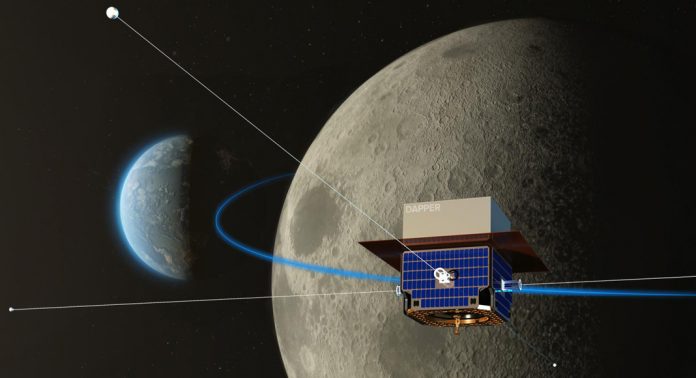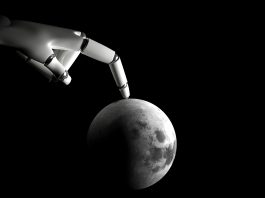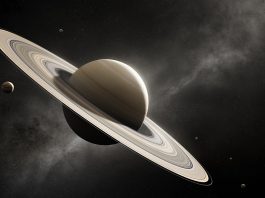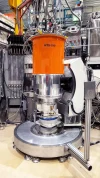Dr Jack Burns, Director and Principal Investigator, of the Network for Exploration and Space Science, spoke to Innovation News Network about missions to the far side of the moon and beyond.
NASA has created the Solar System Exploration Research Virtual Institute (SSERVI), bringing together teams of researchers who are interested in the Moon, asteroids, and the moons of Mars, airless bodies in Earth’s neighbourhood. Most of the teams involved in SSERVI are therefore interested in areas such as lunar geology, resource extraction, and so on. However, the Network for Exploration and Space Science (NESS), which is headed up by Dr Jack Burns at the University of Colorado Boulder, proposed to do astrophysics and cosmology from the Moon, as the far side of the Moon, in particular, is the only truly radio quiet location in the inner Solar System. As such, the far side of the moon is the perfect place to locate radio telescopes that can be used to explore aspects of the Universe that cannot be addressed in any other way. These include, Burns told The Innovation Platform, the so-called ‘dark ages’ of the Universe, the cosmic dawn, and, indeed, exoplanets. “We can also use these telescopes on the far side of the moon to look at the Sun,” he said.
Led by the University of Colorado, NESS has developed into a team of ten universities and NASA centres which have been working together for almost four years. The network is actively involved in addressing some of the broad design questions for missions to the Moon. Burns explained: “We look at the science drivers, undertake theoretical modelling, conduct equipment and instrument design, and plan missions. We have been successful in doing that, and there are a couple of exciting missions coming up in the next few years, and then we will propose more for the longer term.”
The Moon and Mars
In addition to the importance of lunar missions themselves, cis-lunar space is seen as a science-enabling stepping-stone towards a journey to Mars and NESS’s activities are also geared towards realising that. Burns explained: “For the last decade or so, the telerobotics lab here at Boulder has been focused on the design of rovers with mechanical arms that can help to assemble radio telescopes on the Moon. These rovers would be operated either from Earth or perhaps from the lunar gateway – an orbiting spacecraft that NASA is looking to place around the Moon – or, even better still, by astronauts on the lunar surface from their habitats. In this latter scenario, the operators (the astronauts) would experience no delay, in comparison to a delay of over five seconds experienced by operators on Earth.
“We have been experimenting with these rovers and the associated technologies by using virtual and augmented reality software tools to explore how the operators can be trained, both on Earth and the lunar surface. We have also been doing rapid prototyping, which has enabled us to design a set of software tools that are used to control the rovers in both virtual reality and the real world, meaning that we can go back and forth between the two.
“This technology will also be useful for future Mars missions because any astronauts who go to Mars – whether actually landing or taking part in an orbiting mission – will have to work very closely with rovers on the planet’s surface. As such, they will want to operate them in real time rather than, for instance, experience the 40-minute delay that the Earth-based operators of the Perseverance rover have to deal with, which is incredibly time-consuming. If we can provide astronauts with the ability to control rovers in real time, then it is possible for the robots to be able to travel tens of kilometres in a single day. Indeed, one astronaut could even operate multiple rovers at the same time,” NESS’s Director and Principal Investigator concluded.
Of course, using a robot to explore the surface of a planet is never going to be as good as having actual humans on the ground, but it is the next best thing, and so Burns believes that the developments his team are working on for the Moon will directly influence future missions to Mars.
Alongside the work taking place in NESS, others are doing even more relevant work that involves, for example, mining water ice from the Moon’s poles and learning how to turn that into rocket fuel for the return journey. That too will be key to Mars missions because rather than taking the fuel for the journey home with them, the members of a human mission will be able to generate it from Martian resources while they are there. “For that to be achieved, however, we need to know how it can be done, and we will therefore draw valuable lessons from our Moon-based activities,” Burns said.
DAPPER: the first radio telescope on the far side of the Moon
NESS’s Dark Ages Polarimeter PathfindER (DAPPER) project is designed to search for divergences from the Standard Model of cosmology that would indicate new physics, such as the heating or cooling produced by dark matter. It will be the first radio telescope on the far side of the Moon designed for cosmology. As such, it opens up a time period in the Universe that is yet to be explored, the dark ages and the cosmic dawn. According to Burns: “This is a time before the first stars formed, and then as they began to form, and we have no other way of exploring this epoch – the objects are so faint that not even the Hubble Space Telescope or the James Webb Space Telescope are able to help.
“We will be able to do it by using just a simple radio telescope because we are sampling the neutral hydrogen that filled the Universe at that time. And that neutral hydrogen radiates redshifted – low radio frequency emission – essentially in the FM band and below, which is a part of the spectrum that cannot be well studied from the ground because of radio frequency interference and the Earth’s ionosphere.”
By locating this telescope on the far side of the Moon, this frequency regime is being opened up for investigation. “You could argue that this is the last part of the electromagnetic window that is yet to be opened,” Burns told The Innovation Platform. “This is interesting because we want to know whether we have the right model of cosmology, and in this new time period, the dark ages, there is no astrophysics because there were no stars or galaxies; it is all just cosmology, and so we can try to see, for example, the nature of dark matter. We can attempt to understand whether there are multiple kinds of dark matter, warm and/or cold dark matter, and, if so, what role that plays in the overall evolution of the Universe. We can even look for other more exotic things, like a possible early phase of dark energy, which dominates the Universe today in terms of accelerating its expansion.
“It is also exciting because when we look at the cosmic dawn, we will be looking at the very first generation of stars, and that might enable us to answer the age-old questions, where did we come from? How did we come into existence on the Earth? How did the Earth form? How did the Solar System evolve from the very first generation of stars, which we think were very different to our Sun?”
FARSIDE: a low radio frequency interferometric array on the far side of the Moon
DAPPER will be preceded by SunRISE, LuSEE, and ROLSES, and followed by FARSIDE – an array of radio telescopes that will be used to measure the sky average hydrogen spectrum of the early Universe, very much like what COBE did when it made its first observations of the cosmic microwave background (CMB).
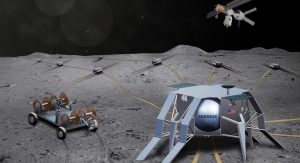
“The FARSIDE array will do what WMAP and the Planck satellite did for the cosmic microwave background (CMB),” Burns explained, “By looking at the three-dimensional structure in the early Universe, and that has yet more information than the spectrum in a similar way that going from COBE to Planck we have learned much more about the nature of the CMB in the early Universe.
“So, for example, with the spectrum we can test models of inflation, such as the different flavours of inflation (a rapid expansion of the Universe shortly after the Big Bang) from the early Universe that have been posited. We can also measure the mass of neutrinos, which is very hard to do in the laboratory; and we can even investigate the different flavours of dark matter. It is a playground for high energy physics and cosmology.”
ROLSES, SunRISE, and LuSEE
Burns is a collaborator on the ROLSES mission, with his colleague, Bob MacDowall, who is acting as the Principal Investigator at the Goddard Space Flight Centre. ROLSES, which is scheduled to launch this November on one of NASA’s new commercial landers as a part of the CLIPS (Commercial Lunar Payload Services) programme, will be the first US radio telescope to be sent to the Moon.
Despite being located on the near side of the Moon, which is not as radio quiet as the far side, ROLSES will nevertheless allow observations of the ionised plasma that results from the solar wind impacting on the lunar regolith, which creates a local ionosphere. “We can use radio waves to measure the density and distribution of that plasma, and we can also use it to measure radio emission coming from the Sun from coronal mass ejections. As we are going to be on the near side, we can also sample the amount of radio frequency interference coming from the Earth, which we know is considerable but which hasn’t been measured for at least 30 years from the vicinity of the Moon,” Burns said.
ROLSES will be followed by SUNRISE, which will be the first low frequency radio array in space, and will be in an Earth orbit, rather than at the Moon. Professor Justin Kasper, a member of Burns’s team from the University of Michigan, is working with NASA’s Jet Propulsion Laboratory to develop the mission because much of the technology it will use will also be utilised in the FARSIDE array. “Because SUNRISE will orbit the Earth, it is going to be very noisy, and the mission will need to look at very bright objects such as the Sun and the radiation that comes from it,” Burns explained.
The next mission will be LuSEE, which will see a lander taken to the far side of the Moon in the Schrödinger impact crater and is within the South Pole-Aitken (SPA) Basin. This mission is being led by Professor Stuart Bale from the University of California, Berkeley, and is scheduled for launch in the second quarter of 2024. Burns said: “As with ROLSES, LuSEE will have relatively simple dipole antennas. However, we have recently proposed to NASA to put DAPPER on that lander as well, combining it with LuSEE to do our first observations. We are waiting to hear back from NASA on whether that is going to be viable. Together, LuSEE and DAPPER would constitute the first cosmology telescope on the Moon.
“We have thus laid out a roadmap and work is underway to achieve it. I have been working on this since 1984, when I delivered the first paper on this proposal at a professional meeting about radio telescopes on the Moon. It is great to look back at the progress that has been made, and our roadmap will take us through the rest of this decade and enable us to establish the first array.”
Man and machine
The combination of humans, robots, and telescopes is something that Burns has talked about at length in the past and is something he sees as being at the very heart of the future of space exploration. Looking back to the science enabled by the Apollo missions, he told TIP: “Dr Jack Schmitt – the lunar geologist who conducted classical geology fieldwork on the lunar surface during the Apollo 17 mission, is a good friend of mine, and when we remember the work he did and as we look towards the future, we can see just how much things have changed. When NASA’s Project Artemis flies to the Moon, we will be taking Silicon Valley with us.
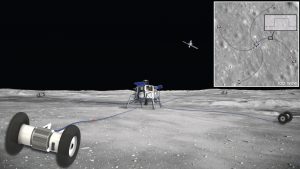
“Indeed, the missions will include a wealth of advanced technologies, including Artificial Intelligence and Machine Learning that can be applied to the robots so that they can be semi-autonomous. But, most importantly, the robot and the humans are going to work together. So, just as when Schmitt went to the Moon it is still important to have a geologist on the lunar surface; but that geologist will have a whole series of robots under her command and she will be able to use them to go out and conduct surveys, hopefully find something interesting, and then radio back to her to let her know. This will increase the efficiency of things like field geology, surveying, and construction, immensely.
“The Apollo missions had a very limited number of those kinds of technologies. Today, we are going to take information technology, robotics, advanced computer technology, advanced software, advanced mechanical systems, advanced electrical systems, low-temperature electronics that can survive the night, and much more with us. This will free up the astronauts’ time, which is the most precious thing on the Moon; they will be much more efficient as a result of humans and robots working together,” he concluded.
Space policy into the future
Of course, as space exploration now seems to be experiencing something of a Renaissance, with the privatisation of space continuing to develop, and as resource exploitation is increasingly investigated as a part of this, space policy needs to similarly evolve. For Burns, this is a topic that can also be brought to bear on the way in which humans and robots will work together in future missions.
He said: “I have always been a big proponent of both the human and robotic programmes because I believe they work well together. I teach a class in space policy here at the University of Colorado and I always make the case that, starting with Apollo, the science programme did well when the human programme was doing well. Moreover, I also point out that without astronauts, the Hubble Space Telescope could never have been serviced and the flaws fixed, or, indeed, upgraded multiple times. As such, the importance of the synergies between humans, telescopes, and robots cannot be understated.
“Of course, one worry we all have is that by generating infrastructure on the Moon to accommodate humans and their activities, we are also risking making the environment too noisy, which would ruin the far side of the Moon for the kind of sensitive observations that we want to make. We must be careful, and so it is important that we keep working with our colleagues in Europe, with those at the UN, NASA, ESA, etc., to ensure that we are all aware of what we can do to shield our electronics from generating low frequency radio waves.”
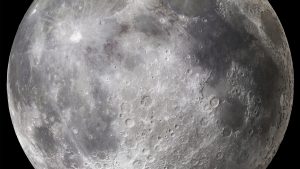
Human exploration activities in and around cislunar space are likely to increase in the next few decades, in addition to activities that develop the Moon. Given the success so far, the emergence of more public-private partnerships is inevitable, with agencies such as ESA and NASA increasingly working with the private sector. A commercial astronaut crew programme is now coming online, as well as things like the commercial resupply of the International Space Station, which has been happening for several years now.
“I believe that will be extended to the Moon,” Burns said. “At NASA, the new human landing system, for example, involves three companies that have been chosen to develop designs, and they will own and operate those landers. NASA will therefore purchase their services, using them to take their astronauts into space in the same way that services are purchased from Boeing or SpaceX to get to the International Space Station.
“Because these vehicles will remain owned by the companies, they will be able to offer their services elsewhere too, flying other astronauts, from Europe, Japan, Canada, Mexico, or anywhere else. Because they will be able to generate significant resources, they will also be flying to the Moon more often than we see at the moment, so we will not have to solely rely on NASA.”
These developments will see the evolution of a true space and cislunar economy over the next decade or so which should soon become self-sufficient, which is what those like Burns have always wanted to see but have been unable to achieve without the development of new technologies and without private companies such as SpaceX, Blue Origin, ULA, and others, making that happen. Indeed, Jeff Bezos’s company, Blue Origin, is already building its own lander, which they plan to put on the Moon, and have also developed a 100-year business plan.
“Bezos wants to create a colony on the Moon,” Burns explained. “He would like to see thousands of people living and working there, developing the infrastructure so that humans become a real spacefaring civilisation. That is certainly a steppingstone, and by the middle of the century it is likely that we will start to see manned missions to Mars. Then, the same kind of thing we will have seen happen on the Moon will need to happen there. After that, there is the possibility of continuing outwards, perhaps to Europa at some point, and then perhaps farther, as we continue to look for life.”
Indeed, looking farther is perhaps one of the fundamental things that makes us human; the desire to know what lies over the next horizon. In this sense, perhaps that thirst for knowledge can be slaked somewhat by the interstellar probe being developed by NASA, which will go beyond the heliosphere of the solar system and into the interstellar medium. Potentially ready for launch within this decade, the probe will be used to measure that true interstellar medium for the first time, an exciting prospect. Nevertheless, that mission will only scratch the surface and humanity will continue to look for the next horizon. In the meantime, perhaps the missions being developed by NESS can reveal some of the secrets that exist a little closer to home.
Please note, this article will also appear in the sixth edition of our quarterly publication.

